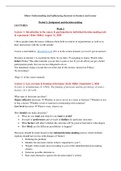College aantekeningen
Volledige aantekeningen Judgement and Decision Making
Volledige aantekeningen van het vak Judgement and Decision making van de minor Understanding And Influencing Decisions In Business And Society. Bevat alle colleges, aangevuld met nuttige afbeeldingen en een duidelijke structuur.
[Meer zien]




